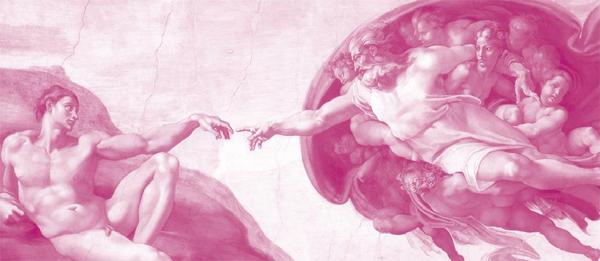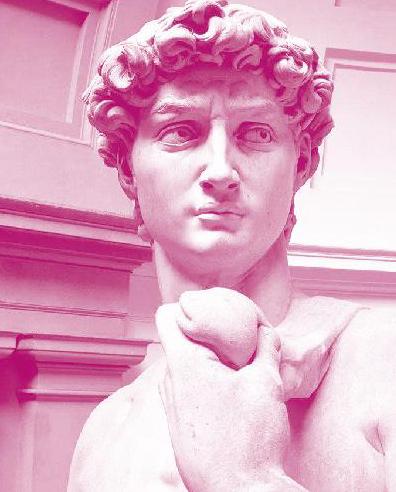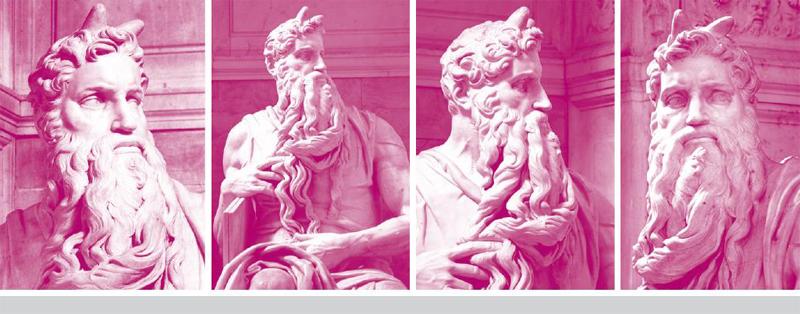四项全能Four in One
By V. M. Hillyer ——V. M. 希利尔(仲秋?译)



TO-DAY there is no famous sculptor who is also a famous painter. But in 1475 was born a man who became world famous as a sculptor, as a painter, and as an architect. He also was a poet and wrote good verses that are still published. Not only that, but he is considered the greatest artist of the Renaissance. Many people call him the greatest sculptor since Phidias.
The name of this wonderful genius was Buonarroti. Have you ever heard before of Buonarroti? Very few people know him by that name. He is known to us as Michelangelo and even this name is written in three different ways—Michelangelo,Michael Angelo, and Michelagnolo.
Michelangelo was trained as a sculptor in marble and he always spoke of himself as a sculptor in spite of the fact that his most famous works are the paintings in the Sistine Chapel in Rome.
As a boy he carved a statue in snow that greatly pleased one of the famous Medici family, the Duke of Florence. The boy was permitted to study the old Greek and Roman statues collected by the duke, who later gave him work to do.
When Michelangelo was still a young man, he carved in marble a wonderful statue called the Pietà. This piece of work shows Mary the mother of Jesus holding her dead Son across her lap after His crucifixion. Some people like it better than Michelangelos other works because it is calmer, quieter and tranquil, than the statues he did afterward.
Some time after making the Pietà, Michelangelo was able to do a piece of work that made him famous throughout Italy. There lay in Florence a huge block of marble that an earlier sculptor had begun to work on, but had been unable to finish because the marble was so long and narrow.
Michelangelo offered to make a statue out of this block of marble. He was given permission to carve it and went to work. The block was set up on end and enclosed with a fence so Michelangelo could work in peace. In three years he had finished. People came in crowds to see what he had done.
It was a colossal statue eighteen feet high, showing David with his sling ready to fight Goliath the giant. Strange to say, every one in Florence called the statue “The Giant”, although it was of a man who killed a giant. It is gigantic in size. It weighs nine tons.
我們生活的今天,没有哪一位著名的雕塑家同时也是著名的画家。但是,有一个在1475年出生的人不仅成为著名的雕塑家,而且同时也是著名的画家。更厉害的是,他还是著名的建筑师,又是一位诗人。他写的很多诗都很优美,有的直到现在还在出版、流传。不仅如此,他还被人们看作是文艺复兴时期最了不起的、杰出的艺术家。有很多人认为他是自菲狄亚斯以来,世界上最优秀的雕塑家。
这位与古希腊最伟大的雕塑家同样了不起的天才叫“博那罗蒂”。你听过这个名字吗?其实也的确很少有人知道这个名字,因为大家都叫他“米开朗琪罗”“米开兰琪罗”或“米高安哲罗”。
米开朗琪罗自幼学习大理石雕像,他也总認为自己是一位雕塑家,尽管他实际上最著名的作品是绘画作品,那就是他为罗马西斯廷礼拜堂所作的穹顶壁画。
在米开朗琪罗还是个孩子的时候,就曾经用雪雕出一座雕像。名门望族“美第奇家族”中的一位成员,当时的佛罗伦萨公爵就非常喜欢米开朗琪罗用雪雕出的雕像。也正因为如此,米开朗琪罗得到佛罗伦萨公爵的许可,学习和研究公爵收藏的古希腊和古罗马的雕像艺术品。后来,佛罗伦萨公爵还为米开朗琪罗介绍了工作。
当米开朗琪罗还是个年轻人的时候,就已经雕刻了一座很了不起的大理石雕像——《圣殇像》。这个雕塑作品展现的是在耶稣被钉死在十字架上以后,圣母马利亚双手抱住耶稣的尸体,放在自己的腿上。有些人认为在米开朗琪罗所有的作品中,他们最喜欢的就是这件作品,因为他们觉得《圣殇像》与米开朗琪罗后期的雕像作品相比,这件的整体感觉更加安详、静谧。
完成《圣殇像》之后,米开朗琪罗回到了佛罗伦萨。在那里,米开朗琪罗完成了使他在整个意大利都很出名的一件作品。当时,佛罗伦萨有一块巨大的大理石,一位前期的雕塑家曾经尝试雕刻这块石头,但最终因为这块大理石很长却太狭窄而没有完成雕刻。
于是米开朗琪罗主动提出,要用这块大理石雕刻一座雕像。得到许可之后,米开朗琪罗便开始着手雕刻工作。人们在这块大理石的周围支起了篱笆,把大理石围在中间,这样他就能够不受干扰地工作了。三年之后,米开朗琪罗完成了雕像。人们得到消息都纷至沓来,想看一看他雕刻出来的成果。
米开朗琪罗雕刻出来的是一座五米多高(原文为18英尺——译者注)的巨型雕像,描绘的是大卫手拿投石器准备与巨人歌利亚战斗的形象。不过奇怪的是,所有的佛罗伦萨人都把这座雕像称为“巨人”。尽管这座雕像雕刻的并不是巨人,而是杀死巨人的英雄——大卫。这是一座庞大的雕像,足有九吨重。
Word Study
sculptor /'sk?lpt?r/ n. 雕塑家,雕刻家
carve /kɑ?rv/ v. 雕刻;切下(肉片);奋斗取得(名声)
The statue was carved out of a single piece of stone.
tranquil /'tr??kw?l/ adj. 安静的;平静的;宁静的
She lives a tranquil life in the country.
colossal /k?'lɑ?sl/ adj. 巨大的;庞大的
niche /ni??/ n. 壁龛;合适的位置
Michelangelo was a very careful student of anatomy. Anatomy is the study of the muscles and other parts of the body. He studied the bodies of people and even cut up dead bodies so he could learn about the muscles under the skin that would make a statue look lifelike. He knew so much about muscles that he carved some of his statues in strained and unusual positions, showing the proper play of muscles under the skin.
For the tomb of one of the popes, Michelangelo carved a statue of Moses. Of course he did not know what Moses really looked like. He had no pictures of Moses to go by, so the Moses he carved is the sculptors idea of what a man like Moses ought to look like. Michelangelo carved horns on his Moses! You can see them in the picture. You remember, perhaps, how the Bible says the face of Moses shone with light when he came down from Mount Sinai? In early Italian translations of the Bible, the rays of light coming from the head of Moses were called by the translators “horns”. And for this reason people of Michelangelos time thought Moses had horns.
The statue is forceful, majestic, powerful. All who see it remember it. Travelers have said it is like seeing Niagara Falls or the ocean or a storm at sea.
As famous as Michelangelos Moses are the groups of statues that he made for the tombs of two members of the Medici family. These tombs are in the Medicis private chapel, in the church of San Lorenzo. Michelangelo placed two figures, a man and a woman, on each tomb. Above these, in a niche in the wall, was placed a statue of the man whose tomb it was. One of these portrait statues is known as the Thinker and the other as the Warrior. The two figures on one of the tombs are known as Morning and Evening and those on the other as Day and Night.
Michelangelo lived to be eighty-nine and died in 1564.
Strange to say, sculpture got worse instead of better after Michelangelo, and it was many years before it began again to improve.
米开朗琪罗还是一位专心学习解剖学的学生。解剖学是主要研究肌肉和人体某些部位构造的学科。他不仅研究活人的身体,还解剖尸体,就是为了清楚地了解人体皮肤下面肌肉的构造,以便使自己雕刻的塑像更加栩栩如生。通过学习,米开朗琪罗对人体的肌肉构造十分了解,因此,他雕刻的许多姿势特别的雕像,比如某一处肌肉紧绷的时候,都能恰到好处地表现出皮肤下肌肉的张力。
米开朗琪罗为一个教皇陵墓雕刻的一座摩西雕像也值得一提。米开朗琪罗当然不知道摩西真正长什么样子,也没有摩西的照片可以参考,因此他就按自己想象中的摩西雕刻出了摩西的形象。从摩西雕像的图片中你可以看到,摩西的头顶居然让米开朗琪罗刻出了一对牛角!或许你还记得,《圣经》上提到过“摩西从西奈山下来的时候头顶放光”。在早期《圣经》的意大利语译本中,摩西头顶上的光环被翻译成了“牛角”。所以在米开朗琪罗时代,人们都以为摩西长了一对牛角呢。
这座雕像的雕刻非常有力度,气势恢宏,所有见过的人都印象深刻。还有参观者说,这座摩西雕像就像尼亚加拉大瀑布、广阔的海洋或者海上风暴一样,让人一见就定格在大腦中,终生难忘。
米开朗琪罗还有一些其他的雕塑作品与《摩西》齐名,它们就是米开朗琪罗为美第奇家族两位家庭成员的墓碑雕刻的几组雕像。这两座墓碑位于圣洛伦索大教堂美第奇家族的私人洗礼堂里。米开朗琪罗在每座墓碑上分别雕刻了一男一女两座雕像。两座雕像上方的墙上各有一个壁龛,里面安放的是逝者的雕像。两座逝者的雕像都是世界闻名的作品,一座叫《思想者》,另一座叫《勇士》。墓碑上的男女雕像分别在逝者雕像的脚下,一座墓碑上的男女雕像分别叫作“清晨”与“黄昏”,另一座墓碑上的男女雕像则被命名为“白天”和“黑夜”。
米开朗琪罗一生活了八十九岁,于1564年逝世。
奇怪的是,在米开朗琪罗出现之后,人类的雕刻艺术没有得到更好的发展,反而是越来越糟了。这种糟糕的情况在很多很多年之后,才逐渐好转起来。

